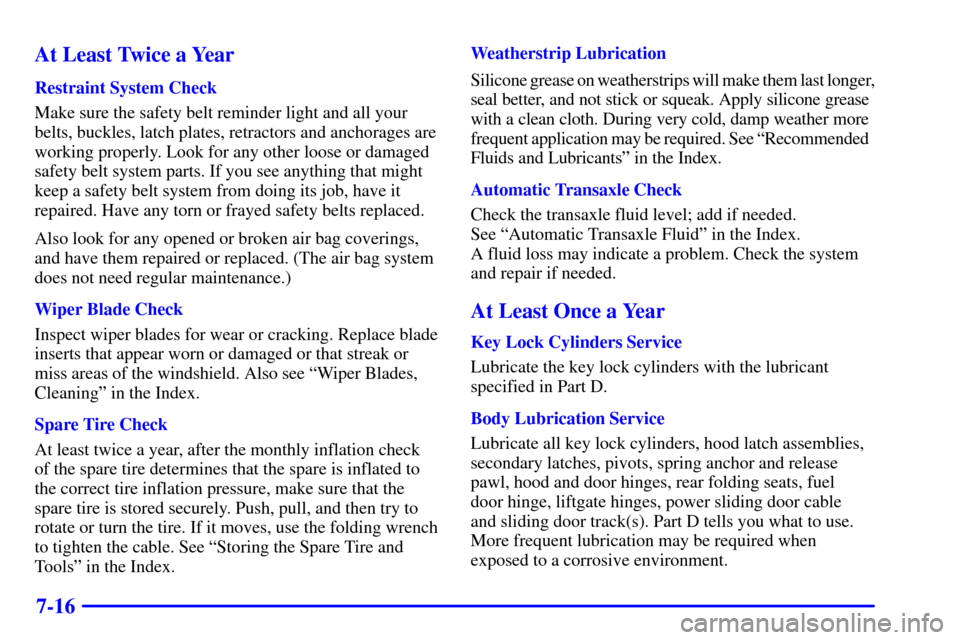Page 12 of 436
Service Station Guide
Oil Viscosity
Engine Oil
See Section 6
Engine Oil Dipstick
See Section 6
Cooling System
See Section 5
Secondary
Hood Release
See Section 6
Windshield Washer
Fluid
See Section 6
Spare Tire Pressure
See Section 5
Battery
See Section 6
Hood Release
See Section 6
Tire Pressure
See Section 6
For
a More
Detailed Look at
What's Under the Hood
See Section 6
Fuel
Use unleaded only.
See Section 6
for octane ratings.
Page 187 of 436
2-95
The main components of the instrument panel are the following:
A. Side Vents
B. Front Vents
C. Turn Signal/Multifunction Lever
D. Hazard Warning Flasher Switch
E. Instrument Panel Cluster
F. Center Vents
G. Audio System
H. Side Vents
I. Exterior Lamp Control
J. Hood Release
K. Audio Steering Wheel Controls (Option)
L. HornM. Ignition Switch
N. Audio Steering Wheel Controls (Option)
O. Climate Controls
P. Rear Fan Controls (Option)
Q. Cupholder Tray
R. Accessory Power Outlet
S. Storage Bin
T. Instrument Panel Switchbank
U. Glove Box
V. Front Vents
W. Instrument Panel Fuse Block
Page 338 of 436
6-9
Checking Things Under the Hood
CAUTION:
An electric fan under the hood can start up and
injure you even when the engine is not running.
Keep hands, clothing and tools away from any
underhood electric fan.
CAUTION:
Things that burn can get on hot engine parts and
start a fire. These include liquids like fuel, oil,
coolant, brake fluid, windshield washer and other
fluids, and plastic or rubber. You or others could
be burned. Be careful not to drop or spill things
that will burn onto a hot engine.
Hood Release
To open the hood do the following:
1. Pull the hood release handle, located on the driver's
side under the instrument panel.
Page 339 of 436
6-10
2. Go to the front of the vehicle and push up on the
underhood release located near the center, under
the grille.
3. Lift the hood.4. Pull forward on the hood prop to release it from its
storage clip.
The hood prop may be hot due to increased engine
temperatures under the hood, so be careful when
handling it. Use your hood prop sleeve when
handling the hood prop.
5. Put the end of the hood
prop into the slot in the
underside of the hood.
Page 415 of 436

7-16 At Least Twice a Year
Restraint System Check
Make sure the safety belt reminder light and all your
belts, buckles, latch plates, retractors and anchorages are
working properly. Look for any other loose or damaged
safety belt system parts. If you see anything that might
keep a safety belt system from doing its job, have it
repaired. Have any torn or frayed safety belts replaced.
Also look for any opened or broken air bag coverings,
and have them repaired or replaced. (The air bag system
does not need regular maintenance.)
Wiper Blade Check
Inspect wiper blades for wear or cracking. Replace blade
inserts that appear worn or damaged or that streak or
miss areas of the windshield. Also see ªWiper Blades,
Cleaningº in the Index.
Spare Tire Check
At least twice a year, after the monthly inflation check
of the spare tire determines that the spare is inflated to
the correct tire inflation pressure, make sure that the
spare tire is stored securely. Push, pull, and then try to
rotate or turn the tire. If it moves, use the folding wrench
to tighten the cable. See ªStoring the Spare Tire and
Toolsº in the Index.Weatherstrip Lubrication
Silicone grease on weatherstrips will make them last longer,
seal better, and not stick or squeak. Apply silicone grease
with a clean cloth. During very cold, damp weather more
frequent application may be required. See ªRecommended
Fluids and Lubricantsº in the Index.
Automatic Transaxle Check
Check the transaxle fluid level; add if needed.
See ªAutomatic Transaxle Fluidº in the Index.
A fluid loss may indicate a problem. Check the system
and repair if needed.
At Least Once a Year
Key Lock Cylinders Service
Lubricate the key lock cylinders with the lubricant
specified in Part D.
Body Lubrication Service
Lubricate all key lock cylinders, hood latch assemblies,
secondary latches, pivots, spring anchor and release
pawl, hood and door hinges, rear folding seats, fuel
door hinge, liftgate hinges, power sliding door cable
and sliding door track(s). Part D tells you what to use.
More frequent lubrication may be required when
exposed to a corrosive environment.
Page 421 of 436
7-22
USAGEFLUID/LUBRICANT
Chassis
LubricationChassis Lubricant (GM Part
No. 12377985 or equivalent) or
lubricant meeting requirements
of NLGI # 2, Category LB
or GC
-LB.
Hood Latch
Assembly,
Secondary Latch,
Pivots, Spring
Anchor and
Release PawlLubriplate� Lubricant Aerosol
(GM Part No. 12346293 or
equivalent) or lubricant meeting
requirements of NLGI # 2,
Category LB or GC
-LB.
Hood and
Door HingesMulti-Purpose Lubricant,
Superlube� (GM Part
No. 12346241 or equivalent).
USAGEFLUID/LUBRICANT
Rear Folding Seat,
Fuel Door Hinge,
Liftgate Hinges,
Power Sliding
Door CableMulti-Purpose Lubricant,
Superlube� (GM Part
No. 12346241 or equivalent).
Sliding
Door TrackLubriplate� Lubricant Aerosol
(GM Part No. 12346293 or
equivalent) or lubricant meeting
requirements of NLGI # 2,
Category LB or GC
-LB.
Weatherstrip
ConditioningDielectric Silicone Grease (GM
Part No. 12345579 or equivalent).